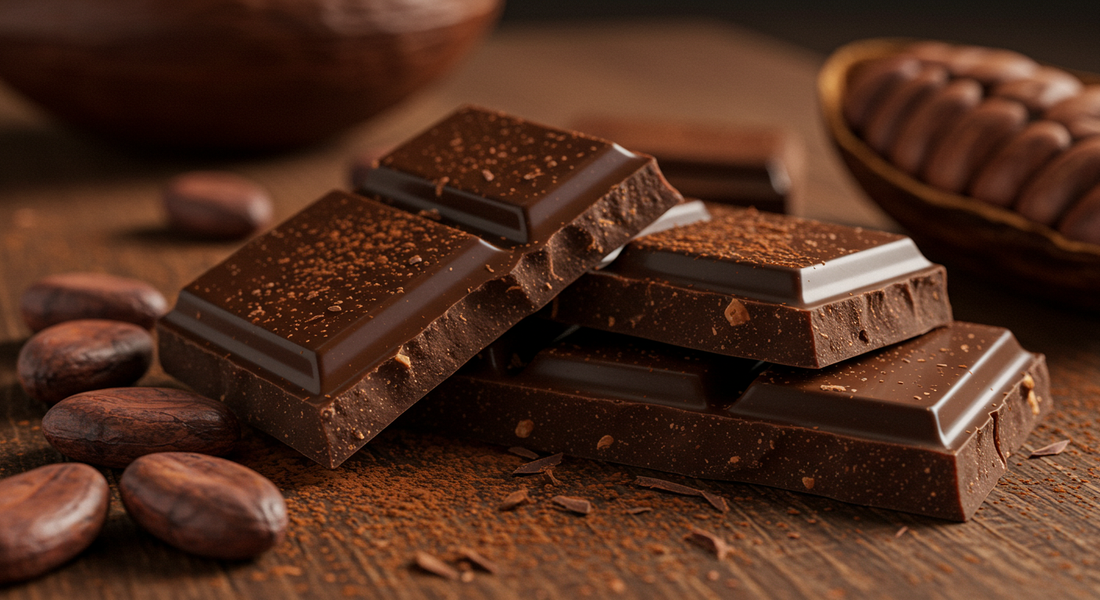
There are so many types of chocolates to try other than the regular dark, milk, and white varieties. Among these, bittersweet chocolate stands out as a star in the culinary world. It’s bitter and sweet at the same time. And this is what gives it a rich, decadent flavor profile. What else does this chocolate have to offer? And how does it compare to its counterparts? Hop on to this delightfully bittersweet journey and read along to know more about this type of chocolate.
What Is Bittersweet Chocolate?
Bittersweet chocolate is a type of dark chocolate known for its high cocoa content and lower sugar levels. The composition gives this chocolate a rich, intense flavor profile. Typically, it contains at least 50% cocoa solids and some varieties can reach up to 90%. As the name suggests, it’s bitter and sweet at the same time. This is also why it’s a beloved choice for so many culinary experts and enthusiasts.
In baked stuff, bittersweet chocolate adds a depth and complexity without overwhelming sweetness. Therefore, it is commonly used in recipes like brownies, ganache, and chocolate cakes, where its intense flavor can shine.
What is Bittersweet Chocolate Made of?
Like all chocolate types, the main ingredient in bittersweet chocolate is cocoa beans. These are the source of cocoa solids and cocoa butter that’s used to make this chocolate. A small amount of sugar is also added to balance the bitterness and enhance the flavor.
According to ecfr.gov, a bittersweet chocolate bar must contain at least 35% of cocoa liquor but most of them usually have 50% or more.
In other words, the major portion of this chocolate’s composition is pure cocoa with only enough sugar to gently tame the intensity. Other ingredients may include lecithin for emulsifying the chocolate and giving it a silky texture. Some chocolate brands also add vanilla to enhance the flavor. You should know that there’s usually no milk fat or unnecessary extras used in the bittersweet chocolate making process.
What are the Ingredients of Bittersweet Chocolate?
Since we just talked about the composition of bittersweet chocolate in detail, here is a recap for you! These are the main ingredients used to make bittersweet chocolate:
-
Cocoa solids
-
Cocoa butter
-
Sugar
-
Soy lecithin
-
Vanilla (optional)
What Does Bittersweet Chocolate Taste Like?
Bittersweet chocolate has a rich, intense cocoa flavor with a gentle bitterness. Because of its high cocoa content, the chocolatey notes hit you immediately. The sugar makes it slightly sweet and balances the taste. It’s not sweet like milk chocolate but not bitter like unsweetened chocolate. Overall, the taste is bold and sophisticated rather than cloying or bitter.
In short, bittersweet chocolate is decadently chocolaty and complex: the sweetness is gentle, the cocoa flavor is king, and the mouthfeel is usually velvety and rich.
Is Bittersweet Chocolate Dark Chocolate?
Bittersweet chocolate falls under the broad category of dark chocolate. This is because it contains high percentage of cocoa solids (around 50% to 90%). Remember, bittersweet chocolate is a variant of dark chocolate but not all dark chocolates are bittersweet. Dark chocolate has various types, including semisweet, bittersweet, and unsweetened chocolates, all differentiated by their cocoa content and sugar levels.
How Is Bittersweet Chocolate Different from Unsweetened Chocolate?
As the name tells, the bitterness in bittersweet chocolate is balanced out by its sweetness. On the other hand, unsweetened chocolate is an intense, no-nonsense variety of dark chocolate. In fact, it is also sometimes called pure dark chocolate. Here is a detailed comparison of both variants:
-
Cocoa Content: Unsweetened chocolate is pure chocolate liquor, containing 100% cocoa solids with no added sugar. It's intensely bitter and mainly used in baking recipes where sugar is added separately. Bittersweet chocolate, on the other hand, typically contains higher cocoa but also has sugar. So, the sweetness of sugar delightfully compliments the bitter taste.
-
Flavor Profile: Unsweetened chocolate delivers a strong, bitter taste. Meanwhile, bittersweet chocolate offers a rich, deep cocoa flavor with a hint of sweetness, making it suitable for both baking and enjoying on its own.
-
Usage in Baking: Unsweetened chocolate is ideal for recipes where you want full control over the sweetness level. Bittersweet chocolate provides a balanced flavor and is often used in desserts like ganache, truffles, and rich chocolate cakes.
While both are forms of dark chocolate, bittersweet chocolate includes sugar to mellow the bitterness. This is why it’s more versatile and palatable for various culinary applications.
How Is Bittersweet Chocolate Different from Semi-Sweet Chocolate?
The main difference between semi-sweet and bittersweet chocolate lies in the cocoa content and sugar levels. In fact, their composition is what that gives them different flavor profile. Here is the detail of how they differ:
-
Cocoa Content: Bittersweet chocolate generally contains a higher percentage of cocoa solids, for a more intense chocolate flavor. Semi-sweet chocolate usually has lesser percentage of cocoa solids that makes it slightly sweeter and milder in taste.
-
Flavor Profile: Bittersweet chocolate offers a deep, rich cocoa taste with a subtle bitterness, appealing to those who prefer a less sweet chocolate experience. Semi-sweet chocolate has a balanced sweetness and is often favored for its versatility in baking.
-
Usage in Baking: Both types are commonly used in baking and can often be used interchangeably. However, if a recipe calls for a specific type, you should use recommended chocolate. Bittersweet chocolate is excellent for recipes where a stronger chocolate flavor is desired, while semi-sweet chocolate works well where a sweeter chocolate is preferred.
Simply put, the choice between bittersweet and semi-sweet chocolate depends on your taste preference and the desired sweetness level in your culinary creations. Both are quite popular and you can easily find them in the market. Moreover, both are a great choice for your cookies, cakes, garnishes, etc.
|
Type |
Cocoa Content |
Sugar Content |
Best Uses |
|
Semi-Sweet |
High but lower than bittersweet. |
Moderate |
Chocolate chip cookies, brownies, general baking |
|
Bittersweet |
Higher |
Low to moderate |
Ganache, truffles, sophisticated desserts |
|
Unsweetened |
Highest (up to 100%) |
None |
Recipes where sugar is added separately, like brownies or cakes |
When Was Bittersweet Chocolate Discovered?
The history of bittersweet chocolate goes way back to the ancient civilizations of the Maya and Aztecs. These people didn’t just recognized cacao for its bold, bitter flavors but used it in their rituals too. But the bittersweet bar we know and love today didn’t really take shape until much later. In the 19th century, chocolate makers in Europe began refining cacao into smoother, sweeter forms. They were seeking out something that was a balance between bitter and sweet.
Thanks to the high-tech in chocolate processing (like the invention of the cocoa press in 1828), chocolatiers could finally craft solid chocolate with varying degrees of sweetness. And this is how bittersweet chocolate was born! It became the perfect middle ground: rich, intense, yet just sweet enough to amp up other desserts.
What Are the Uses of Bittersweet Chocolate?
Bittersweet chocolate isn't just a treat for the taste buds—it's a versatile ingredient that can elevate both sweet and savory dishes. With its high cocoa content and balanced sweetness, it brings depth and richness to a variety of recipes.
Baking
Undoubtedly, baked items get star-studded with this chocolate. Are you an aspiring baker or already an expert? Regardless, you should know about the wonders of this chocolate. So, here you go:
-
Brownies & Cakes: Its intense cocoa flavor makes it perfect for fudgy brownies and decadent chocolate cakes.
-
Ganache & Truffles: Melted bittersweet chocolate creates silky ganache and luxurious truffles.
-
Cookies & Muffins: Chopped chunks or chips add a sophisticated touch to cookies and muffins.
Desserts
Not just baking, bittersweet chocolate stands tall in the whole industry of desserts. Whether its chocolate ganache, ice cream, or anything else, it becomes even more delicious with bittersweet chocolate.
-
Chocolate Mousse: Provides a rich base for airy and indulgent mousses.
-
Chocolate Fondue: Melts smoothly for dipping fruits, marshmallows, and more.
Savory Dishes
This one seem unusual to some, but its true: bittersweet chocolate is used in many savory dishes. This is because of the flavor enhancing abilities of cocoa. Here are some common ways of using it in savory items:
-
Mole Sauce: Adds complexity to traditional Mexican mole, balancing spices with deep cocoa notes.
-
Chili & Stews: A small amount enhances the depth of flavor in hearty dishes.
Snack Mixes
Just like other types of chocolates, bittersweet chocolate can also be a great pick-me-up. Although it’s not commonly eaten as-is, but you can surely do so. In fact, those who have a knack for the dark chocolate flavor will surely enjoy it. Here is how it can be used for snacking:
-
Straight Up: Enjoy a square or two for a satisfying, less-sweet chocolate fix.
-
Pairings: Complements nuts, cheeses, and dried fruits on a charcuterie board.
Whether a show-stopping dessert or adding a twist to a savory dish, bittersweet chocolate is the IT INGREDIENT of your dessert. Undoubtedly, it is your go-to for an indulgent flavor in your favorite food items.
Conclusion
Clearly, bittersweet chocolate is a special ingredient in so many dishes. So, it’s correct to say that its magic goes beyond regular chocolate types. With its rich cocoa taste and balanced sweetness, it makes both sweet and savory dishes even better. Chefs and home bakers love using it in recipes like fudgy brownies, creamy truffles, and flavorful mole sauces. As you discover more about chocolate, be sure to try bittersweet chocolate. Its unique flavor is really worth a shot if you are a true chocolate lover. Add it into your desserts and dishes and she how they become more delightful than ever. Grab some and enjoy the bittersweet indulgence in all your favorite recipes.








